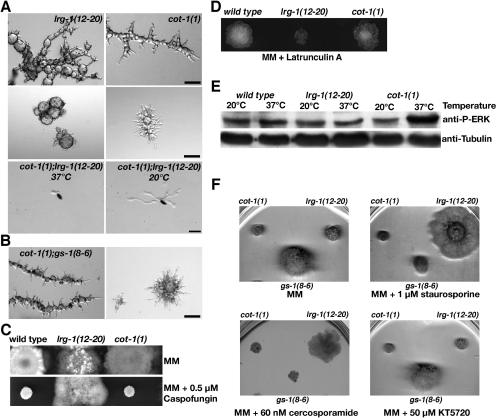Figure 8.
LRG1 acts in a pathway parallel to the Ndr kinase COT1 (A) lrg-1(12-20) and cot-1(1) displayed nearly identical defects with tip extension terminating with 2–10- and 10–30-μm-long pointed tips, respectively, when shifted from permissive to restrictive conditions for 12 h (top panel) or when germinated at 37°C for 15 h (middle panel). Double mutant ascospores germinated at 25°C produced compact, highly vacuolated and slow growing hyphae. Germination at 37°C resulted in apolar germination and death of lrg-1(12-20);cot-1(1) ascospores. (bottom panel). Bars, 40 μm. (B) Double mutants of cot-1(1) and gs-1(8-6) did not display synthetic defects after shift to restrictive temperatures (left image) or when germinated under restrictive conditions (right image). Bar, 40 μm. (C) The growth behavior of cot-1(1) is identical to wild type on medium supplemented with 0.5 μM caspofungin. (D) cot-1(1) is not hypersensitive to the addition of 0.5 μM latrunculin A. (E) Total soluble protein of the indicated strains grown at 25 or shifted to 37°C for 10 h was extracted. The Blot was probed with an anti-phospho-ERK antibody to detect increased MAK1 activity levels in cot-1(1) grown at restrictive conditions (top panel). To confirm equal loading the blot was reprobed with anti-tubulin antibody (bottom panel). One example of five consistent experiments is shown. (F) The PKC-specific inhibitors staurosporine and cercosporamide partially suppressed the tip extension defects of lrg-1(12-20), but not those of cot-1(1). The growth of wild-type cells was not affected by the mentioned conditions. One example of three consistent experiments is shown.

